Table of Contents
Blue Ram Cichlid Overview
Blue Ram Cichlid, also known as German blue ram, is a beautiful and peaceful fish that is popular among aquarists. If you have experience in keeping fish and want to explore the cichlid species, then start with this one.
They are vibrant in color and texture. They do well in captivity and are known for their social behavior which is contrary to other cichlids.
| Information Chart | Blue Ram Cichlid |
| Scientific Name: | Mikrogeophagus ramirezi |
| Family: | Cichlidae, Subfamily: Geophaginae |
| Care Level: | Moderate |
| Temperament: | Calm and peaceful |
| Color: | Yellow, blue, and white |
| Lifespan: | 2-5 years |
| Size: | 2-3 inches |
| Diet: | Omnivore |
| Minimum Tank Size: | 10 gallons |
| Temperature: | 82–86-degree Fahrenheit |
| Water Conditions: | The pH should be between 6.0-7.5, Hardness should be 2-6 GH |
| Tank Mate Compatibility | Social |
The Appearance of Blue Ram Cichlid
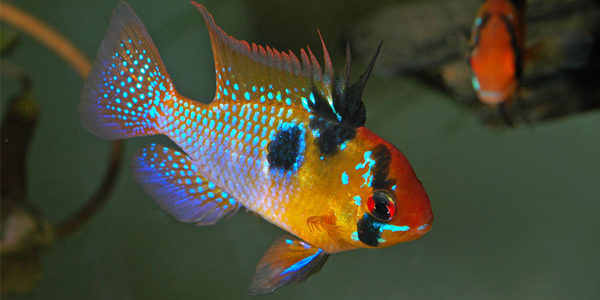
The German blue ram cichlid is color and vibrant in appearance. It is one of the striking fish that elevates the color of any fish tank. It comes in blue, yellow and white colors. Their head and chest are gold, yellow, blue, and black, with red patches on the abdomen.
The flanks are gray or blue with a vertical black line crossing the eye, and the pelvic fins are red with blue.
The eye of the electric blue rams is red, and the fins have a tint of yellow with blue lines which are transparent. In most of them, the dorsal fin is black. The black curved lines that run along the body with the black dot in the middle are mostly found in the wild rather than the captives.
The Lifespan of Blue Ram Cichlid
The typical lifespan of the Blue Ram Cichlid is 3-5 years. However, in captivity, if proper care is taken, they can survive more than three years, while in the wild, they survive 4-5 years.
Blue Ram Cichlid Size
The typical German Blue Ram Cichlid typically grows up to 2-3 inches. However, they are small fish and do not grow too much.
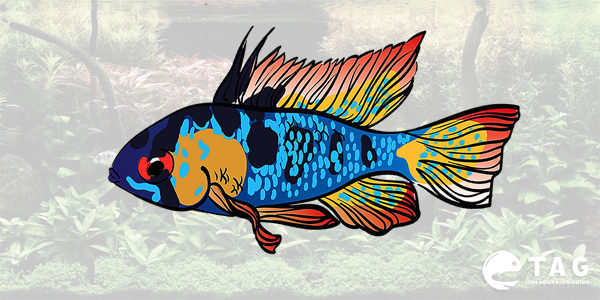
Natural Habitat and Origin
The Blue Ram Cichlids are native to South America. They are small freshwater fish and are found vastly in the streams of the Amazon rain forest and Amazon River. In addition, they are found in Venezuela and Columbia in the Orinoco river basin. The wild Blue Ram Cichlid is found in shallow streams or pools where there is a sand bed. They are found in streams near dense vegetation.
These fishes are tropical fish, which means they are more accustomed to the slow-flowing stream with plenty of sand beds and submerged aquatic vegetation.
With the knowledge of their natural habitat, you can create a similar replicate atmosphere inside the tank.
Blue Ram Cichlid Care And Tank Setup
Before bringing home Blue Rams Cichlid, you must make sure your tank is ready to give maximum care to the fish in captivity. Most of the beginners aren’t aware of the water parameters for the husbandry of German Blue Rams. Blue Ram should always be kept at high temperatures with some plants, ferns, and substrate. Here in this section, we will discuss in length the different parameters that should be kept in mind while caring a blue Ram.
Blue Ram Cichlid’s Tank Size and Specification
The minimum tank size for a Blue Ram is 10-gallons, but you’ll need at least a 29-gallon aquarium if you intend to add other fishes.
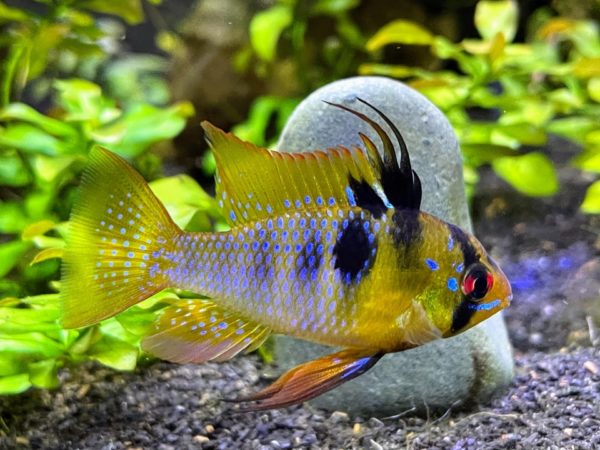
However, Ram Cichlids need pristine air quality, and they thrive well when there is ample water to swim across one part of the aquarium to another. In addition, they do well in 20-gallon tank size as they get enough floor space in 20-gallon tanks.
If you are keeping more than one female, then you would need a 30-gallon tank size. However, if you are keeping more than one male, you would need a 40-gallon tank size. This is because the males are large, and if you keep them in a big tank, it would be safer for them as it would prevent the scope of fighting.
- Quality and performance driven products for your pet
- Tested for safety and health
Optimum tank Size for Blue Ram Cichlid
The optimum tank size for German Blue Ram Cichlid is 29 gallons.
Tank Shape
The ideal tank shape should have a wider surface area at the bottom. The Blue Ram cichlids are bottom dwellers, and they like to dig in the sand. There would be fewer fights between the tank mates when there would be enough space for every fish in the tank at the bottom.
Filter Type
These fishes are sensitive to change in water parameters. They are prone to sickness if the level of ammonia or nitrite spikes. So, it is in the best interest to provide enough filtration to dispose of the fish waste properly. The filtration makes sure that ammonia doesn’t build up in the water.
We would recommend you get a filter that has a lot of space for biological filter media. Filter like Seachem Tidal or AquaClear power filter is some of the examples of filters with a lot of room for filtering out the biological waste.
Substrate
Sand is the best substrate for German Blue Ram cichlids. They are bottom-hovering fishes who like to dig in the sand. Their natural habitat is mostly found in shallow water where the sand bed is present. This is because they can dig in the sand like they do in the wild.
In addition to that, you can use gravel or soil from any aquatic plant. You can pick these along with sand, but the sand should be the primary substrate.
If you put sand as substrate, avoid aragonite sand, also known as “cichlid sand”. The aragonite is made of calcium carbonate, which will constantly leach minerals in the water. This will impact the balance of water parameters. It will increase the carbonate hardness (KH), general hardness, and pH value.
So, it would be better if you went for inert sand that would not impact the water chemistry.
How Many Blue Ram Cichlid Can Fit In 30-Gallon A Tank?
You can keep 2 male German blue ram cichlids in a 30-gallon tank.
Water Parameters for Blue Ram Cichlid
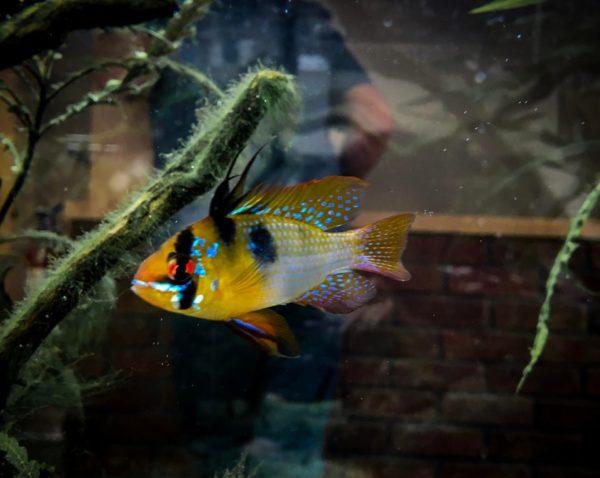
The water parameters for blue ram cichlid should mimic their habitat. They live in warm water rather than ice-cold ones. So, you must keep the temperature high and have a heater installed in the tank to maintain the temperature. Moreover, they are intolerant to ammonia and nitrate, so always ensure the pH balance is maintained in the fish tank.
Water Temperature
The ideal water temperature for keeping Blue Ram Cichlid is 78-85 degrees Fahrenheit.
Water Flow Rate
The water flow rate for Blue Ram Cichlid should be slow to moderate currents.
Ph Level
The pH level of the water in the fish tank should range between 6.0-7.5. They are tropical fish, so acidity in water can be harmful to them. Use a pH level indicator to learn about the pH range of the water you are putting in the tank.
Water Hardness
The hardness of the water should be between 6-14dGH. Therefore, the general hardness or GH of water in the fish tank should be 3-6dGH, while the carbonate hardness or KH should be 3-5dKH.
Blue Ram Cichlid Tank Landscape
When it comes to decorating the interior of the fish tank and creating a landscape, it is crucial to keep in mind their habitat. They have very specific needs in plants and decor when they are kept in captivity. The tank must have aquatic vegetation along with ample free space for swimming. In the different sections of this part of the article, we have described the ideal landscape to keep the blue ram cichlid.
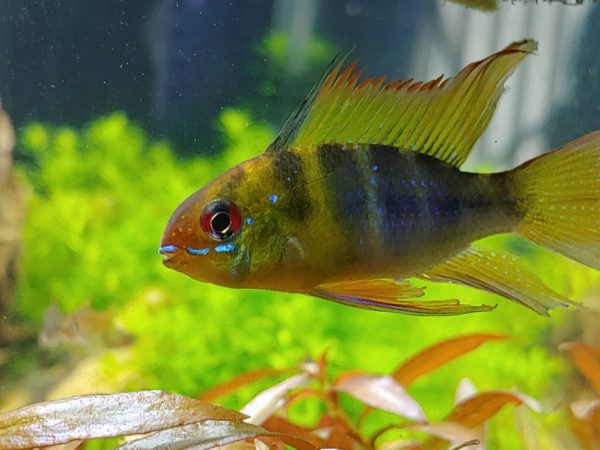
Best Plants for Blue Ram Cichlid Tank
They are found in the densely vegetative area of the amazon river. Therefore, they are more acquainted with aquatic vegetation. Therefore, it is best to plant aquatic plants on the substrate of the tank.
You can plant species such as Amazon swords, cryptocorynes, Vallisneria, Sagittaria, and java ferns. Plant these in the front and back section of the tank. Keep the middle area open.
- All the equipment needed to get started in one box
- Low profile full hood contains vibrant cool white LED lighting to bring your aquatic environment to life
Worst Plant for Blue Ram Cichlid Tank
Plants that do not survive in high temperatures should be avoided. In addition, floating plants should be avoided as they float freely on the surface of the water and hinder the oxygen requirement of the fish.
Decoration For Tank
Blue Ram Cichlid need caves to hide when they feel threatened by another fish in the tank. You can construct the cave with some rocks or make a hidey-hole for them. You can use some driftwood and rocks to make the cave for the fish.
Lighting For Tank
It should have moderate to subdued lighting.
Nitrogen Requirement for Blue Ram Cichlid
There should be no ammonia and nitrate in the fish tank as Blue Ram cichlid are sensitive to ammonia. To understand this, you have to understand the nitrogen cycle.
The nitrogen cycle is the breakdown of wastes in the tank that turns into toxic and non-toxic substances. It works in a cyclic procedure. Fish defecate, or any form of food crumbs, is the waste in the water that surrounds the fish. This waste starts to rot in the aquarium. We know it is not one of the best things to visualize, but it’s the truth.
When the waste rots in the tank, it puts off ammonia, which is highly toxic. I part per million of ammonia can kill your fish. So, learning about the nitrogen cycle can help your fish stay safe.
The waste in the water keeps building little by little and releases harmful toxins in the water, such as ammonia or nitrate. This can lead to the death of all the fish in the tank. Good filtration is the right method to keep this waste at bay. In addition, the bacteria in the fish tank helps in detoxifying the waste. For example, a kind of bacteria eats up the ammonia and releases nitrite.
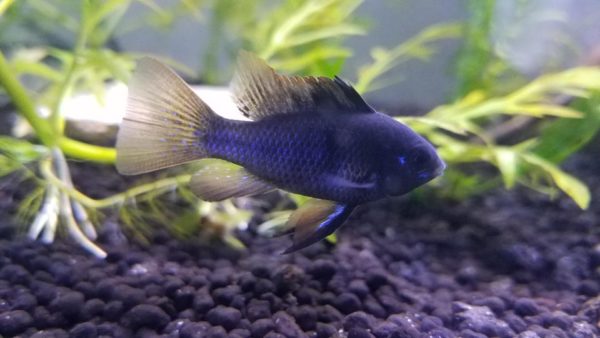
Nitrite is also very toxic, and the fish is sensitive to nitrite. However, some other bacteria eat nitrite and release nitrate. So, nitrate is also not a great companion in the aquarium. However, it is less harmful than nitrites. So, it can be left in the tank, and in weekly water changes, the nitrate is easily released. The whole process, from turning ammonia to nitrate, is called the “nitrogen cycle”. Getting beneficial bacteria that colonize the filters is called the “cycling” of the tank.
Feeding of Blue Ram cichlid
As omnivorous fish, the Blue Rams require both plant matter and animal food.
When introducing them to your aquarium, don’t panic if they lose their appetite.
This is a normal behavior in most fish and for the first days, try feeding them rich and tasty treats like larvae or frozen food.
After they are established in your tank, gradually try cichlid flake food or pellet food, and soon your cichlids will accept a wide range of foods.
The Best Diet for Blue Ram Cichlid
The best diet for Blue Rams is to provide them omnivorous food with many meaty ingredients and plants. Supplement your fish with tubifex worms, blood worms, Mysis shrimp, baby shrimp, and brine shrimp.
How Often Should You Feed Your Fish?
Feed Blue Ram Cichlid 2-3 times a day. Feed them small meals in a day instead of a large portion at once. They are heavy eaters; you might feel like they don’t need food much, but they eat a lot for their size. However, their stomach is tiny, so they can’t digest much quickly. Provide them enough food that they can eat in 30 seconds to 1 minute.
Blue Ram cichlid Behavior and Temperament
The Blue Ram Cichlid is a peaceful fish, and they like living in the community. They are not attackers and do not indulge in fights. However, they have quite contrary behavior from other cichlids.
When you are setting up the tank for them, keep in mind they like to swim a lot, so there should be enough free space in the tank.
Are Blue Ram Cichlid Lone or Societal Fish?
They are societal fish. They live in a community, and they prefer a peaceful environment to live in a tank. They do not thrive well in the aggressive tank.
- Combo includes aquarium, reflector and electrical 24" light fixture
- Acrylic aquariums are clearer than glass, 17 times stronger, and only half the weight!
Blue Ram Cichlid Tank Mates
As we have mentioned before, Blue Rams are social and community fish. They thrive well when they are kept with other peaceful fishes. So, before you pick potential tank mates for blue ram cichlid as yourself:
- Can this fish handle the high temperature in the tank?
- Is it a peaceful community fish?
When you can answer both questions as “yes” then you should pick it up for the tank. While if the reply is “no,” then you must avoid it as a Blue Ram tank mate.
Ideal Blue Ram Cichlid Fish Tank Mates
Bad Tank Mates for Blue Ram Cichlids
Avoid aggressive fishes for Blue Rams. If they show signs of aggression, it might be due to a lack of nutrients or in their breeding season. Be watchful of these signs. Shift them in the breeding tank during the breeding season.
Breeding Blue Ram Cichlids
After you notice a blue ram breeding pair, you can move them to their tank to establish a family.
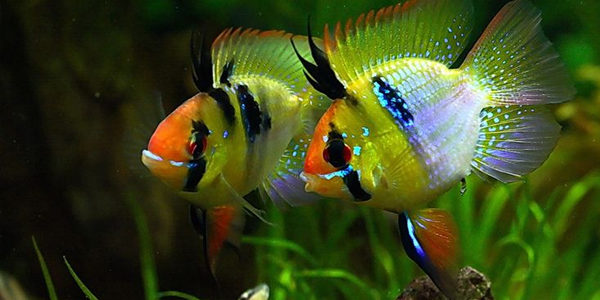
The water in the breeding tank should be warmer, between 82-86° Fahrenheit, and wide leaves or smooth pebbles should be available for the female to lay eggs on.
Water should be very clean, and all stress factors should be avoided, as the stressed pair will eat their eggs.
Other fish can distract them and make them less aggressive, so adding some to the breeding tank would be good.
After the fry hatch, the parents should be removed if the tendency of eating them is observed.
Usually, the female digs a pit in a remote place and guards the fry there.
Another possibility is the parents splitting the fry between themselves and guarding their fry in a separate pit.
Blue Ram Cichlids Breeding Level
- Easy
Blue Ram Cichlids Sexual Dimorphism
It is easy to differentiate between male and female Blue Ram Cichlid. The females are usually small in size, and they have a colorful appearance. They have a pointed head. The pectoral fins of the female are smaller than the male.
Males are larger than females and have a round head with a slimmer body shape. The pectoral fins are twice as long as females. The tip of the fin reaches the tail when it is folded back. They have prominent colors and rays on the dorsal fin and spikes on the fin’s rest.
Blue Ram Cichlids Common Diseases
The Blue Rams are prone to the usual diseases of tropical fish.
They may become stressed in poor water quality, not enough oxygen, or there aren’t enough hiding places.
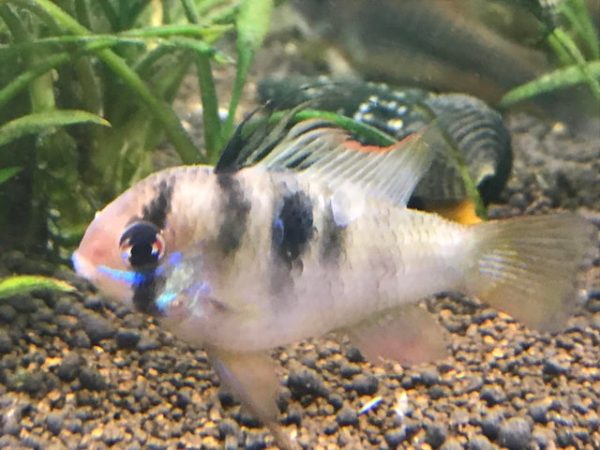
Extended stressful periods weaken your cichlids’ immune system and make them more vulnerable.
Ich
Ich is the first and most common disease affecting freshwater fish.
Also, Blue Rams are prone to parasitic infections, bacterial diseases, flatworms, skin flukes, or Costia disease.
Tuberculosis
They are also prone to fish tuberculosis. The tuberculosis of fish is passable to humans, so immediately seek medical care if you notice the blue ram becoming thinner or developing any ulcer in the head or eye. Use gloves when putting them in a different tank. Make sure you do not come in direct contact with the water.
Facts About Blue Ram Cichlid
- Blue Ram Cichlid uses smell to communicate with others.
- Blue Ram Cichlid is called butterfly cichlid due to its vibrant colors.
- These fishes are picky eaters; if you soak the food in garlic juice before giving it to them will encourage them to eat more.
Is Blue Ram Cichlid Suitable for You?
The blue ram cichlid is not the easiest to take care of due to their susceptibility to water parameters and terrible TB. Therefore, you need to be more advanced in taking care of fish in blue ram.
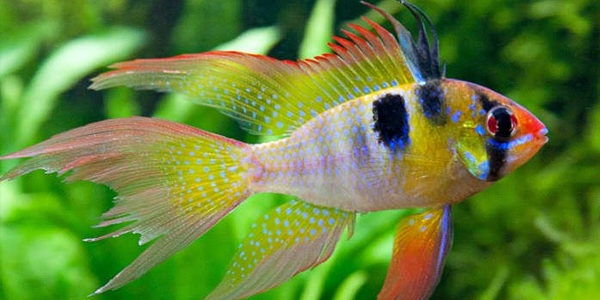
We would recommend you keep make strict maintenance schedule of the tank and keep the tank clean as much as possible. These little fish need maintenance and care, but I think they are worthy of it! The brilliant color will surely make them a piece of pearl in the fish tank.
Frequently Asked Questions
Can Blue Ram Live Alone?
Unlike most cichlid blue rams are societal fish. However, if you keep them in a 10–15-gallon tank, they can live alone. They are peaceful fish; they spend most of their time swimming and hiding in the caves in the aquarium.
Can Blue Rams Live with Guppies?
The blue rams are not like other cichlids, and they are not aggressive fish. This dwarf cichlid makes a good companion with guppies. Apart from dwarf cichlid, the riverine cichlid is peaceful and makes a great tank mate with guppies.
Are Blue Ram Cichlid Hard to Keep?
No, Blue Ram Cichlid is not that difficult to keep as they are not aggressive fish. But they are sensitive fish, so you must be careful with the water parameters. They are sensitive fish and require a large tank to stay. In addition, they are prone to disease, so if you are keeping one, be strict with the cleanliness schedule.
Why My Blue Rama Are Fighting?
Blue Rams show dominance by fighting with similar kinds. So, if you have two male blue rams in a tank, there is a possibility they will fight. Swap them with female blue ram or put them in a tank with different fish.
Conclusion
In different sections of this Blue Ram Cichlid care guide, we have listed information like breeding, tank set up, and fish feeding. They live at the bottom of the tank and do not cause any disturbance to middle or upper-level dwellers in the tank. These little creatures sometimes need extra maintenance, but they are worth it!
No related posts.


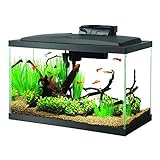

13 thoughts on “Blue Ram Cichlid: Complete Guide to Care, Breeding, Tank Size and Disease”
Could they be kept in a 30 gallon with cherry barbs, kuhli loaches and fancy guppies
Yes,just be sure that your school of cherry barbs is large enough (minimum 5 fish) to avoid fin nipping issues. Make sure you have three female guppies for every one male you have to prevent them from being aggressive towards other tank mates. Khuli loaches also like to be in schools and spend more time out of hiding that way 🙂
Thanks for this; very informative! I currently have a well-established 25g unplanted tank housing 4 corys and 9 neon/cardinals. My pH is 7 and GH is 12. What are your thoughts on adding 1 male and 1 or 2 female GBRs? Because the corys’ natural waters are on the cooler side and the tetras prefer it around 80, I settled on a temp of 76.5-77. Thanks again!
Thanks so much for the info. I am thinking about getting a blue ram for my 30 gallon. I have goldfish in it too—do you think they will get along well? I also have a weather loach— or do you think that I should get a smaller Cichlid for my 5 gallon? Thanks so much
I wouldn’t put the ram with goldfish first because gold fish require colder water and Rams warmer. Second is that goldfish produce a lot of waist. Goldfish do good in a only goldfish tank because they get picked on as well
Can you keep them in just groups of females because i dont want them to mate
Would German Blue Rams do good in a tank that is 36 inches long by 12 inches front to back by 18 inches tall? Would celestial pearl danios, guppies, cory cats, shrimp, and empire gudgeons be good tank mates? If not, what tank mates would be a good selection?
I recently got one, a male, and he is doing great. I’ve been in the hobby for almost 1,5 years now, starting out with a 10 g I got after a brave encounter at the dentist office. I was pretty drugged up and thought “ye I want one!” A few hours later it dawned on me what I had done, but I took my responsibility, as one should. I didn’t really like it at first, but then I quickly grew to like fishkeeping, so much so that I got myself a 7-8 g tank for a Betta.
My ram has lived with a platy and a few male fancy guppies since I got him. I thought that he might be really hard to keep, a new challenge to overcome, but he took to the community like a seal to water. He loves it, the plants, dark hiding spot and the thriving beneficial bacteria has done wonders on him.
They truly are a peaceful fish and I totally recommend them.
I have a 60Gal established aquarium with 11 zebra danios, 2 angelfish, 6 Cory’s, and 1 Bolivian ram. I was wondering if it would be okay to add just 1 blue ram with them? Thanks in advance!
I recently purchased a german blue and a longfinned electric blue ram i had them in the tank for a week so far and they have been inseparable. Now i noticed the longfin has been bullying the german blue. I have increased their food supply but it hasn’t seemed to help. Any thoughts?
I’m looking at German blue rams at a aquatics store. There are a couple that have white spots described as “scale” not ich. Is this an actual thing? Is it curable?
I would love to no if You can keep blue ram in A10 gal thank I have blue Ram and electric Blue Ram in my thank I no if one is mail or a female there in a 10gal with 5 mother tater with live plants but they keep changing the other one around what should I do to keep them charging each other
Could the rams be in a tank with dwarf grouami Cory cats angelfish one pleco and two phantom tetras